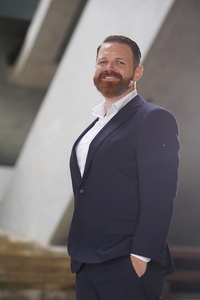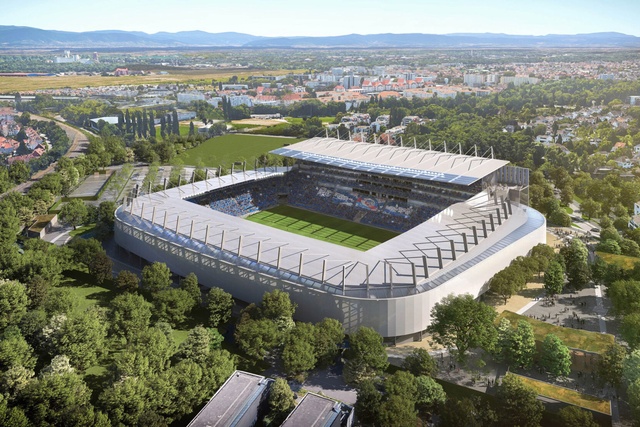Up with the play! Creating experiences for the future
Sharing ideas with James Pearce, Populous, by Haley Hooper.
It was inspiring to spend time with Kiwi architect, James Pearce of Populous Architects sharing in his ideas. Populous is a globally leading design firm that has become known for designing immersive, multifunctional sport, entertainment environments from stadiums and arenas to event spaces and urban precincts. The ethos of Populous is based on ‘making the places where people love to be together.’ Creating those places that amplify the joy felt in shared human moments. Those experiences that capture the senses.

James is a key speaker at the up and coming CoreNet’s Global NZ Symposium ‘Unconventional Disruptors’, to be held on 15th August 2024, in Auckland. James will speak about topics including disruptive design concepts that challenge traditional venue typologies, the integration of building typologies into precincts and how a holistic approach enhances community engagement and maximises impact, creation of immersive digital environments, and smart venues equipped with advanced connectivity for real-time interaction among other themes.
In discussion with James, I had the opportunity to ask him some questions and share in his answers. It was clear he is a progressive thinker, with an animated, positive spirit and a genuine care for design excellence, in particular design excellence, at scale.
What will lead our futures ?
“Celebration of change, adaptability and evolution.”

Excitement, energy and celebration drives a lot of what James does in design. It was evident that James sees that things are rapidly evolving in the entertainment space. Where once stadiums may have been a more removed single focused facilities at the peripheral areas of cities, now they are becoming key anchors and multi-use hubs very much in the city - ingrained into the urban fabric in a very close and complementary way. He prompted the question - to us as designers to understand and explore – ‘How we come together as people? And understand how we celebrate?’
‘Unconventional Disruptors’ Where is property and development heading and what can better shape the trajectory?
Tech and digi-disruptors are disrupting at the large scale in which we are working, James sees the value in the amplification of the change possible when it is across whole communities, neighbourhoods and precincts.
For James it is fascinating thinking how we may shape these places and consider colocations, multiplicity of activity and all interactions, not just single use of days gone by. Thinking really multiple use, multiple experience. James’ hones his ability to smoothly and easily transverse between considerations of the uniqueness and specialty of different activities, and the sum of all parts.

You can hear in James’ voice his love and dedication for realising complex project briefs and the joy in seeing the precinct approach coming together in a well-designed way, rather than just a collection of individual projects that happen to be side-by-side. He makes me think in agreement with him, that it is in considered and finely curated colocation that one finds the grand artistry of place.
“At Populous, we try to push to get the most out of the ‘parts’.”
In the past, the tradition has been its solely a stadium or arena, or a neighbourhood, or a convention centre, or a resort. Now perhaps it is all those things together, as well as including many other uses too, and it is destinational but also exists as a very daily, everyday life type of place, catering for both everyday use and event-use.
‘We know the old ‘live, work + play’ tripartite, but at Populous we place the emphasis on the play part where entertainment is a leading anchor feeding into the day-to-day aspects.’ James believes that these projects need to become ‘good neighbours’, like the International Convention Centre (ICC) in Sydney, which is a theatre, exhibition centre and convention centre, three venues all connected, yet having a unique expression in relation to their surrounding urban context, cityscape, parklands, waterfront. Today’s city venues are working as part of our city, rather than a part-removed, they are embedded and contributing to city life.
What is the role of public place, civic place, forum for collective experience now and in the future? Why is gathering important?
“I think gathering together brings joy, that becomes part of our core of memories, where we create strong bonds and lasting connections to that moment.”
Covid showed us that there is a real desire to come back together, and the demand for collective group experience has rapidly increased since Covid times. Gathering helps us to not only form connections with familiar faces, but also to engage with others. It’s those times together that you look back on later, with heart. It’s foundational to design for all, and really dive deep to see how may ‘everyone’ enjoy these spaces.
What is ‘entertainment’ in your own words?
“I think entertainment is feeling heightened emotion! Love! Joy! Something to hold on to, to cherish it and create a memory from it. We don’t want to just ‘fill in our time’ in this life!”
Now bring in the digital overlay where digital representation is creating a e-lifestyle, perhaps a business forum, a community, where you can engage, work and enjoy also.
How are boundaries blurring between the digital and physical worlds and how does this influence design, experience and society?
“The digital and physical worlds are coming together, we look to develop these spaces in parallel and see two worlds that happen in conjunction with each other, like digital twins; where you get double wins and you can maximise the physical experience utilising the digital overlays.”
James comments that remote digital connectivity is so curious, for example with major sports teams, they will have a large portion of their fan-base that will never visit the physical home stadium, but have a huge following in the digital space. Another question for architects - how can we provide the same excitement of experience and chances to have a strong connection to team, place and experience through digital architecture.
What is regenerative design, resilience and sustainability in design for you?
“It is having consideration well, well beyond just our own existence towards that future. It is ensuring that from day-1 regenerative design, resilience and sustainability is built in to address environmental and societal impacts, and offer benefits much beyond our own life.”
James encourages the architectural profession to seek out the ways of designing better, ‘there are lots of new opportunities in this space, to be striving forward’. The renovation project for Strasbourg State de la Meinau in France, includes interesting upcycling features such as innovative reuse of 4,400m2 of decommissioned A340 airbus fuselage sections to create the sunshade for the main façade sunshade alongside;
- Installation of 1,000m2 of photovoltaic panels
- Rainwater recycling facilities
- Site connection to a heat network powered by renewable energy (biomass)

Describe your current interests in architecture in 5 words
“Biophilic design at precinct scale.”
Why do architects matter?
“Architects bring it all together, all the insights, each part that becomes one. We are the curators, and the composers. As Goethe said, ‘Music is liquid architecture; Architecture is frozen music.”
Architects have the key instruments of design and make sure that it ‘is’ all bought together, and James believes we can’t lose sight of how critical that is. As things evolve some may say it’s not as necessary, but it’s more necessary than ever. We need the architect’s capability to reach the collective point, and arrive at the well composed and well-integrated outcome. It must also be said, that the role of the architect must continue to dynamically evolve.
Favourite place in New Zealand
“After 14 years in Brisbane, coming home and spending time with family and friends in Highland Park in Auckland, cooked meals, you just can’t beat it. But for a holiday, I would say Queenstown.”
James’ parting words — “Think bigger, bolder. Take hold of our “scale of thinking”, and the chance is there. Legacy is significant. It excites me to keep working for those opportunities to create fundamental connections to people, place, history and future.”
I am proud to think we have talented New Zealand architects like James out there innovating with the flows of change, passionate about architecture and positive about our ability to influence outcomes for city making and shaping…
…and always coming back home for a good home-cooked meal or two!









